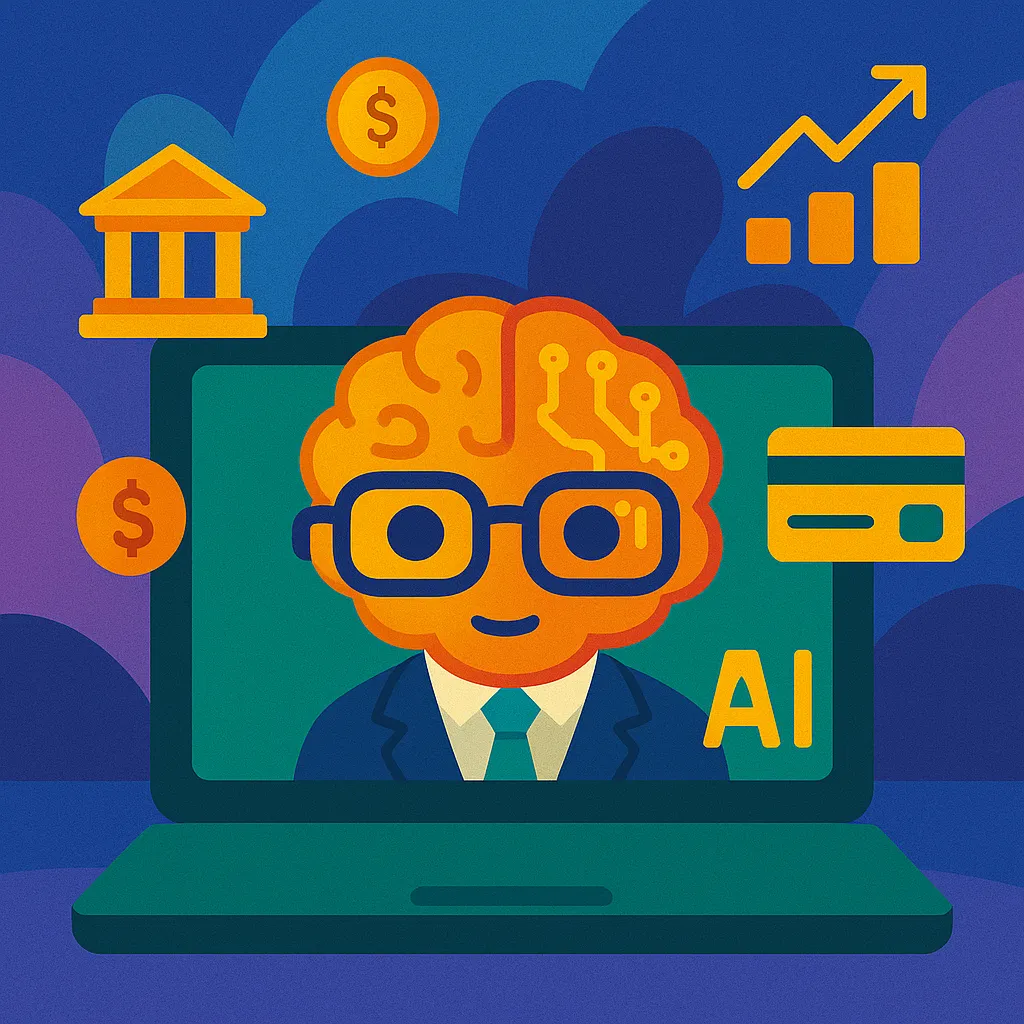Redefining Banking with AI: A Technology-Driven Transformation
Artificial Intelligence (AI) has become the cognitive engine driving banking’s most dramatic transformation. From decision-making algorithms to contextual assistants, AI is reshaping the way banks operate, serve customers, and assess risk — unlocking speed, personalization, and resilience across the industry.
This is more than just an upgrade. AI in banking introduces a fundamental shift in how services are delivered and decisions are made. For banking customers, this means:
- Frictionless Efficiency: Rapid approvals, streamlined processes, and real-time responses.
- Tailored Experiences: Hyper-personalized service available 24/7.
- Advanced Fraud Detection: Proactive protection through behavior-based monitoring.
- Data-Driven Advice: Financial insights that evolve with your goals.
Let’s explore how AI is transforming banking from the inside out.
Core Use Cases of AI in Banking
AI is embedded across banking workflows, driving smarter, safer, and more customer-centric services. These applications go far beyond automation — they enhance judgment, accelerate decision-making, and provide financial institutions with strategic capabilities once thought to be aspirational.
Real-Time Fraud Detection: Intelligent Protection in Action
Fraud is one of the most pressing challenges for financial institutions. Traditional systems rely heavily on static rules and historical data, often falling short against increasingly sophisticated attacks. AI-powered fraud detection goes further by analyzing real-time behavioral and transactional data to proactively stop fraud before it occurs.
Picture a customer enjoying a beach vacation while someone halfway across the world attempts a high-value purchase using their account. AI systems immediately detect the anomaly, analyzing the user’s usual location, transaction history, and biometrics.
Before any money leaves the account, a biometric prompt is triggered, asking for fingerprint or facial confirmation. The customer rejects the attempt, and the transaction is blocked. AI’s layered defenses prevent financial loss while ensuring minimal customer friction.
AI uses machine learning models trained on millions of data points to detect subtle indicators of fraud, such as unusual device fingerprints, time-of-day transaction anomalies, or behavioral deviations. This enables banks to evolve from reactive fraud detection to continuous, proactive fraud prevention.
Conversational AI: Reinventing Customer Service
The traditional call center model is giving way to a more modern, AI-powered paradigm of customer service. Conversational AI platforms leverage natural language processing (NLP), sentiment analysis, and contextual awareness to deliver responsive, intelligent customer interactions at scale.
Take Alex, a busy banking client. While exploring car loan options via a mobile app, an AI chatbot engages them naturally, recommends loans based on savings behavior, and answers common questions before they’re even asked. If deeper support is needed, the AI escalates the query to a human agent — fully briefed.
These AI systems can handle thousands of interactions simultaneously, reducing wait times and elevating the overall service experience. They are multilingual, emotionally aware, and capable of handling requests across a wide range of banking products — from checking balances to managing investments.
AI transforms customer service from reactive support into proactive partnership, increasing customer satisfaction and loyalty.
Personalized Financial Guidance: Hyper-Targeted Advisory
Wealth management and personal finance have long relied on generalized advice and manual intervention. AI is disrupting this model by enabling real-time, personalized financial guidance that’s informed by deep analysis of customer behavior, preferences, goals, and market trends.
Jordan, a savvy investor, receives a push notification suggesting a meeting to discuss sustainable tech stocks. Behind the scenes, AI has assessed Jordan’s portfolio, market trends, and behavioral patterns.
In collaboration with a human advisor, AI surfaces tailored strategies and pre-built portfolio recommendations. Jordan confidently proceeds with the proposed investments, impressed by the relevance and responsiveness of the guidance.
AI can recommend savings plans, identify cost-saving opportunities, predict future financial challenges, and even simulate long-term financial outcomes. By providing clear, customized options, AI bridges the gap between financial knowledge and actionable insight.
Smart Risk and Credit Assessment: Accelerated Decisioning
AI’s ability to process vast amounts of structured and unstructured data is transforming how banks evaluate creditworthiness and manage risk. Traditional credit scoring often misses the nuances of a borrower’s financial picture. AI brings holistic context, speed, and scalability to risk assessment.
When Sam, a small business owner, applies for a loan, traditional models might hesitate. But AI evaluates a broader data spectrum: business performance, industry health, regulatory risk, and even market sentiment.
By analyzing structured and unstructured data at scale, AI recognizes Sam’s potential and recommends approval with mitigated risk. The loan is approved in hours instead of weeks.
AI enhances fairness by reducing bias in decision-making and increasing financial inclusion. It enables real-time credit scoring, dynamic risk modeling, and continuous portfolio monitoring — all while ensuring regulatory alignment.
AI Behind the Scenes: Operational Excellence
AI isn’t only transforming customer-facing services — it’s optimizing operations beneath the surface, creating efficiencies that ripple across every business line.
Process Automation (RPA): 24/7 Accuracy
Robotic Process Automation (RPA) takes over repetitive, time-consuming tasks that used to require human intervention. Whether it’s onboarding new customers, processing loan applications, or validating transaction records, RPA delivers reliable, scalable automation.
From document verification to account setup, RPA handles repetitive, rules-based tasks at scale. This reduces human error, increases throughput, and frees staff to focus on higher-value activities.
By integrating AI into RPA workflows (known as intelligent automation), banks can automate decision-based processes, enabling the system to adapt and improve over time.
Predictive Analytics: Informed Foresight
Predictive analytics in banking goes beyond trend analysis. It anticipates events — customer churn, loan defaults, or market volatility — and recommends proactive actions. AI enables this by drawing insights from real-time data, past behavior, and macroeconomic signals.
Banks are no longer limited to reacting. Predictive models powered by AI uncover insights into customer churn, default risk, and economic shifts. This empowers banks to proactively intervene and adapt offerings.
A bank that identifies a recurring pattern of business account closures in year three can offer targeted advisory programs to reduce attrition. Similarly, AI can recommend preemptive offers or interventions to retain high-value customers at risk of leaving.
Compliance Automation: Seamless Governance
Banks face an evolving regulatory landscape — anti-money laundering (AML), data privacy laws, and complex compliance rules. AI empowers compliance teams with tools that automatically detect anomalies, validate identities, and cross-check regulatory databases.
Know Your Customer (KYC) and Anti-Money Laundering (AML) checks are foundational — but historically labor-intensive. AI streamlines these processes through cross-verification, anomaly detection, and real-time alerts.
An AI system might instantly flag a new account registration with mismatched identity details, preventing fraud and maintaining regulatory compliance. It can also track ongoing activity to ensure accounts remain compliant, reducing audit risks and operational strain.
Overcoming Challenges in AI Adoption
While AI brings transformative potential, successful implementation depends on navigating several key challenges.
Data Security and Ethics
Protecting customer information is paramount. Banks are leveraging secure AI frameworks, encryption, and privacy-first architectures to ensure ethical AI deployment. Bias audits and explainability models are being adopted to ensure fairness.
Regulators are increasingly scrutinizing AI decisions, requiring transparency in how models make choices. Banks must demonstrate that AI tools are explainable, auditable, and aligned with ethical guidelines. Customer trust hinges on responsible AI governance.
Talent Transformation
AI complements, not replaces. Banks are upskilling employees to work alongside AI, focusing on hybrid roles where human empathy and judgment enhance AI insights.
The workforce is evolving to support AI literacy. Analysts, compliance officers, and even branch managers are being trained to interpret AI recommendations and augment them with human insight. This collaborative approach elevates both human talent and machine capabilities.
Investment and ROI
Though initial setup costs are significant, long-term benefits in cost reduction, risk mitigation, and improved CX justify the investment. Successful banks treat AI as a strategic capability, not just a tech upgrade.
Executives must frame AI investments with clear KPIs tied to cost savings, revenue growth, customer satisfaction, and risk reduction. Pilot programs and phased rollouts allow institutions to iterate quickly and demonstrate measurable success.
The Road Ahead: Strategic Implications
Looking forward, AI is becoming central to strategic banking innovation. It is not simply a tool for automation but a cornerstone of how financial institutions will compete and deliver value in the digital age.
Personalized Banking Experiences
AI powers hyper-personalization — from financial advice to product recommendations — curated by behavior, life stage, and personal goals. Conversational AI creates always-on, adaptive engagement across channels.
From recommending customized credit cards to predicting life events that might require financial products, banks can engage customers with tailored content that anticipates needs, not just reacts to them.
Open Banking and AI Synergy
Open banking enables AI-driven insights across institutions, delivering holistic financial guidance. Customers benefit from aggregated data intelligence and tailored services — with control and consent at the core.
As APIs proliferate, AI acts as the integrator — harmonizing cross-platform data into actionable insights. This new model unlocks customer-centric ecosystems where banks become trusted advisors across their financial lives.
AI + Blockchain: Security Redefined
Combining blockchain’s immutability with AI’s pattern recognition unlocks next-gen security. Smart contracts, fraud detection, and identity management benefit from this powerful convergence.
Imagine real-time fraud detection systems that update blockchain records instantly when suspicious activity is detected. Or loan contracts that self-execute and monitor risk continuously. AI and blockchain are a formidable pair for financial innovation.
Conclusion: AI as the Future of Banking
AI is not simply a trend; it’s a foundational shift in how banks operate, serve, and grow. From real-time fraud prevention to personalized financial coaching, AI makes banking more responsive, inclusive, and secure.
The future of banking lies in human-AI collaboration, where machines handle scale and precision, and humans provide empathy, creativity, and trust. Institutions that embrace AI’s full potential will redefine customer value, strengthen risk management, and lead the next era of financial innovation.
Banks that move decisively building trusted AI frameworks, empowering employees, and designing customer-first experiences won’t just keep up. They’ll lead the transformation shaping the next decade of banking.



